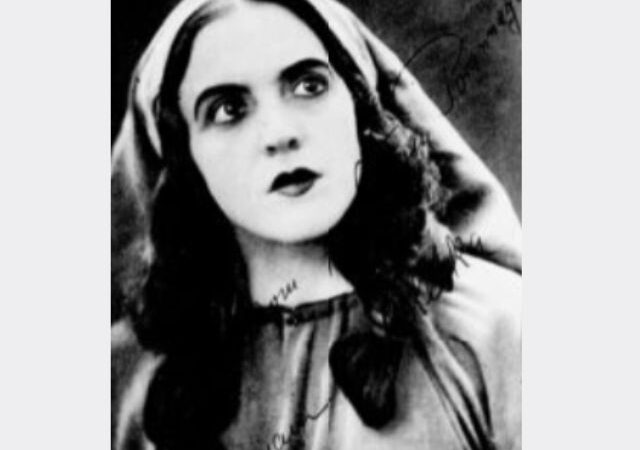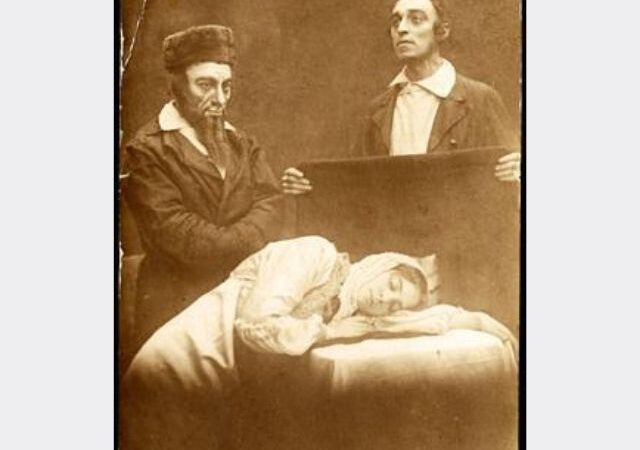Miriam Orleska (1900–1942)
A popular stage actress, associated with the Vilnius Troupe and theatres in the Warsaw Ghetto.
Miriam Orleska was born in 1900 in Warsaw. From an early age, she showed acting talent, eagerly appearing in school plays. At the age of 9, she joined the team of the outstanding theatre director Dawid Herman and played the role of little “David” in the play “Mitn Szorm” based on the play by Shalom Ash. She studied then at the Pedagogical Institute, and also in secret from her family, she learned acting at renowned courses with Helena Hryniewiecka, Antoni Bednarczyk and Aleksander Zelwerowicz.
In 1919, she began working with the Vilnius Troupe (Wilner Trupe) – an avant-garde theatre company performing in Yiddish. For the needs of working in the team, Orleska learned Yiddish. A year later, in 1920, she played the breakthrough role of Lea in Szymon An-ski’s “The Dybbuk” directed by Herman. The performance, staged at the Elizeum Theatre, turned out to be a huge success and was presented over 300 times, including abroad – among others, in Germany, Austria, England and Romania.
Thanks to the role of Lea, Miriam gained international fame. Austrian writer Robert Musil compared Orleska to Eleonora Duse, calling her “the most beautiful actress since Duse appeared on stage”, adding: “One would like to see this actress in a great role on the European stage, perhaps Desdemona”.
In the following years, Miriam Orleska performed in many plays, m.in in “Kiddush Hashem” based on Shalom Ash, directed by Michał Weichert.
Another significant role was Portia in the play “Szejlok” – a Yiddish translation of William Shakespeare’s “The Merchant of Venice”, also directed by Weichert. Mojżesz Kanfer, in a review published in “Nowy Dziennik” (a Polish-language Jewish newspaper), wrote about her performance: “Very nice, downright charming was Mrs. Orleska, as Portia”., Jakub Appenszlak in his review: Shakespeare’s The Merchant of Venice at the Vilnius Troupe Theatre (Nasz Przegląd 1929, no. 62), wrote: “The most beautiful was the construction of Act III in Portia’s house, whose character was reproduced with unadulterated grace and finesse, with an almost perfect appearance, by Mrs. Miriam Orleska.”
Orleska’s performance of Portia was considered by theatre critics to be one of the most important achievements in the history of Yiddish theatre in Poland. Its significant contribution to the transformation of the image of Jewish theatre towards an ambitious stage, presenting the classics of world drama, including Shakespeare’s works, was emphasized. The stage role of the actress was also exceptional due to the expressiveness of the interpretation, the power of expression and its meaning. The embodiment created by a woman in Shakespeare’s Jewish theatre, which was strongly dominated by men, showed the actress’s independence and artistic courage.
The artist was associated with the Vilnius Troupe for several years, both professionally and privately — with its director Mordechai Mazo.
Actor and director Jonas Turkow, in his book “Farloszene sztern”, described Miriam Orleska as one of the most popular actresses of the interwar period, valued in both Polish and Jewish artistic circles. He appreciated her beauty. Thanks to her high personal culture and European sophistication, she gained many fans in the theater environment.
In 1930, she played the main role in the play “Black Ghetto” (Yiddish. Shvartze ghetto), an adaptation of Eugene O’Neill’s drama “All God’s Chillun Got Wings”, translated from English into Yiddish by Jakub Rotbaum, the director of the play. The story of discrimination against African-Americans in America, in Poland, played a different role: “It was 1930, anti-Semitic moods and riots. In both Warsaw and Vilnius, students attacked Jews in the evenings, Jewish shops were smashed, and it was necessary to protest somehow. This play was to fulfill this task,” Rotbaum wrote after the war.
The director also recalls how one day, while returning home from a rehearsal of the play “Black Ghetto”, he and Miriam Orleska were attacked by a group of students carrying canes covered with razor blades. Miriam was badly injured, but despite serious injuries, she managed to return to the premiere.
After the outbreak of World War II and her imprisonment in the Warsaw Ghetto, Orleska continued her artistic activity. She played, among m.in others, in the Femina Theatre and the Nowy Teatr Kameralny – both in Polish and in Yiddish (she was one of the few actresses combining both languages). She performed, for m.in, in the extremely successful play “Matura”, directed by Jonas Turkow.
She also promoted Yiddish culture in the ghetto as a co-founder of the underground cultural organization Yikor. As a clerk in the Jewish Social Self-Help, she investigated the financial situation of people seeking help. She also worked in the folk kitchen of Rachel Auerbach at 40 Leszno Street from the beginning of its existence. Auerbach wrote about her in her memoirs: “My closest friend from the last period in Warsaw, my dearest artist Miriam Orleska (…).”
In the summer of 1942, during the Great Liquidation Action, Miriam Orleska was deported to the Treblinka death camp, where she was murdered.
Bibliography:
Polski Słownik Judaistyczny, tom 2, Warszawa 2003.
Auerbach R., Pisma z Getta Warszawskiego, Warszawa 2016.
Dąbrowska A., Żydowskie aktorki z Polski w rolach szekspirowskich w teatrze jidysz[w:] Studia Judaica 24 (2021).
Person K., Assimilated Jews in the Warsaw Ghetto. 1940-1943, Nowy Jork 2014.
Teatr Żydowski w Polsce, Kuligowska-Korzeniewska A., Leyko M. (eds.), Łódź 1998.
Turkow I., C’était ainsi: 1939-1943, la vie dans le ghetto de Varsovie, Paryż 1995.
Turkow I., Farloszene sztern, t. 1, Buenos Aires 1963.
Zylbercweig Z., Leksikon fun yidishn teater , Nowy Jork 1931.
Nasz Dziennik, nr 162, 1929.
Nasz Przegląd, nr 62, 1929.
Gazeta Żydowska, nr 32, 1942.



